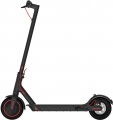Max. power
The power in watts that the electric scooter motor can develop at maximum speed. In general, for scooters with an electric drive, it is customary to indicate the rated engine power (see above), which ensures efficient operation of the motor for a long time. By maximum, we mean power in the “gas pedal to the floor” mode, achieved only in the short term. Using this parameter, you can roughly estimate the capabilities of a particular model, for example, in terms of speed dynamics - the more power, the faster the scooter accelerates.
Pedestrian mode
The slowest speed mode (approximately from 0 to 5 – 6 km/h), is ideal for use in crowded places, for children and beginners. It controls the e-scooter while it moves at a safe speed for pedestrians to avoid collisions on crowded sidewalks.
Pedestrian mode is also suitable for leisurely walks and side-by-side trips with walking frien
Max. climbing angle
The maximum climbing angle that an electric scooter can overcome on engine power alone, without the help of legs. Models with engines of the same power may differ in this indicator (due to the difference in torque and wheel size).
Note that in the specifications the angle is usually indicated in degrees, while on road signs it is given as a percentage (1% corresponds to a rise of 1 m for every 100 m of horizontal movement). However, this moment is not particularly critical: if you often have to overcome a certain hill, you can clarify its slope by converting percentages into degrees (and vice versa) according to special tables. In addition, if the angle turns out to be too large, nothing prevents you from helping the scooter with your foot, in extreme cases, to overcome the climb on foot.
Front brake
Among the various types of brakes in scooters, you can find
rim,
disc,
drum,
electric. There are also models without a front brake.
- Rim. The rim brake is considered the simplest type of braking system. Such brakes provide a smooth deceleration and a complete stop of the scooter at an average speed. The stopping distance is usually medium or long. The rim brake is represented by pads, which, using a special mechanism, are pressed against the wheel rim. The pads themselves are driven by a lever, which is placed on the handlebar. Among the advantages of a rim brake are low price, and simple design. And drawbacks are fairly quick wear of the pads and the need to adjust the brakes as the friction linings wear out. Additionally, when using a scooter with a rim brake, be aware that the pads become less grippy if the rim is wet. In rainy, cloudy and slushy weather, the rim brake cannot be relied upon.
— Disk. Disc brakes are considered more advanced than rim brakes. The disc brake allows the scooter to stop quickly enough, and the braking distance itself can be either minimal or medium. Such brakes are represented by a friction clutch that acts on a small-diameter disc. The disc is attached to the wheel axle. The clutch is pressed against the brake disc with a sufficiently large force, which allows the disc brakes to b
...e effective even when wet on the clutch. The disc brake is controlled by a lever that is placed on the handlebar. The advantages of a disc brake for a scooter are reliability, durability and the ability to stop quickly. Among the shortcomings, we highlight the high price and the need to adjust as the friction clutch wears out.
- Drum. Drum brakes slow down well and provide a fairly quick stop. In terms of efficiency, the drum brake for a scooter is between the rim and disc brake systems. The drum brake uses pads that are located inside the rim. In this case, the friction plates act on the inside of the rim. The brake with a drum device has many advantages: a large friction contact surface, moisture protection, reliability and durability. Among the shortcomings can be noted: the use of massive wheels, the complexity of service maintenance, and the need for periodic adjustment.
- Electric — braking with the help of recuperation. In this case, the deceleration and stop are produced by the electric motor itself, by reducing the speed. Usually, the electric brake provides a soft and smooth stop. As a rule, the electric brake acts as an auxiliary brake system. Also, advanced scooters often use a recuperative electric brake. In this case, when the speed is slowed down, energy is recovered, which allows you to recharge the battery pack.
- No brake. The front wheel is not equipped with a brake system. The braking can only be provided at the rear.Battery capacity
Battery capacity installed in the electric scooter.
Theoretically, a higher battery capacity allows for a longer range, but in fact, not everything is so clear. Firstly, motors of even the same power can differ in efficiency; secondly, the actual amount of energy stored in the battery depends not only on the capacity in amp-hours but also on the voltage in volts. So this parameter is secondary, and when choosing, it is worth focusing not so much on the battery capacity, but on the directly claimed range. You can compare capacity only for models with similar characteristics and the same supply voltage.
Voltage
In general, this parameter is of secondary importance; in fact, it is needed mainly when looking for a spare / replacement battery or a third-party charger. When choosing, it is worth paying attention to characteristics that are closer to practice - in particular, directly claimed speed and power reserve.

